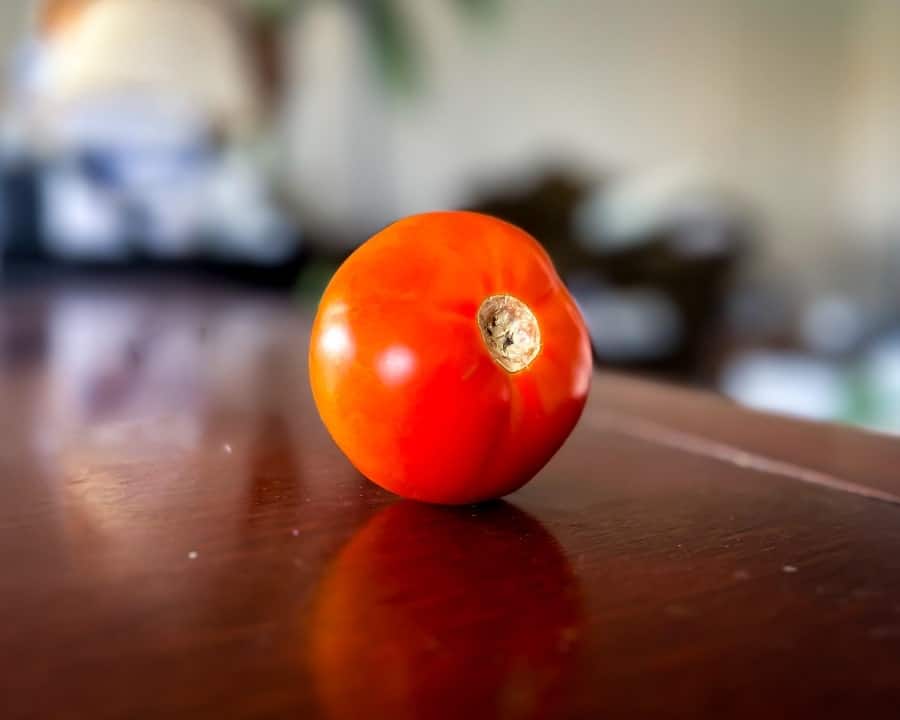Iguanas are reptilian herbivores, more specifically, folivores, a type of herbivore that eats primarily leaves. However, their diet can include certain vegetables and a small amount of fruit.
Although not recommended, iguanas can eat tomatoes, just not in large quantities as fruits tend to contain high levels of phosphorus and not much calcium. Feeding an iguana large quantities of tomatoes can upset the delicate 2:1 Calcium to Phosphorus balance contained in the lizard’s system, resulting in health complications. Additionally, iguanas tend to avoid acidic food altogether. If given the opportunity to eat a tomato, most iguanas will take a pass.
If you decide to incorporate tomatoes into your iguana’s diet, take the following precautions.
Can Your Iguana Safely Eat Tomatoes?
Technically speaking, your iguana can safely eat tomatoes as their diet consists of vegetables, leaves, and fruits. However, keep in mind that, unlike humans, iguanas don’t have digestive enzymes in their saliva.
Therefore, eating acidic foods such as tomatoes, pineapples, lemons, oranges, and kiwi fruit, can be hard on their stomachs, resulting in digestive issues.
Some iguanas will avoid tomatoes altogether.
After giving tomatoes and strawberries a couple of whiffs, then licking them, my iguana stared into space for about a minute, as they always do, and climbed back up to its basking area. That was the last time I tried to feed her acidic foods.
I highly discourage feeding any type of acidic foods to your iguana, as there are a myriad of better alternatives to choose from, which you can see below:
However, if you insist on testing whether your iguana likes tomatoes, do so only after you’ve read the bottom section of this post to ensure you’re taking the necessary safety precautions.
If you’re not sure what comprises the best iguana diet, check out this post I wrote regarding exactly what iguanas eat.
Pros & Cons Of Feeding Tomatoes To Iguanas
Like most types of foods on the planet, eating tomatoes can be both beneficial and harmful, depending on the quantity consumed. You’ve probably heard the saying, “Everything in moderation, even moderation.” The same is true for iguanas and tomatoes.
Downsides
Upset Digestive System
Tomatoes are classified as acidic foods. Even one serving of tomatoes can be enough to upset your iguana’s digestive system.
Additionally, tomato seeds and skins can be difficult for the iguana to digest, resulting in an upset stomach.
Imbalanced Calcium to Phosphorus Ratio
Tomatoes contain oxalates which bind calcium to crystals. If consumed in excess, tomatoes can negatively affect the calcium-to-phosphorus imbalance, leading to kidney complications and possibly metabolic bone disease (MBD).
Tomatoes have an extremely poor Ca:P ratio of 0.3:1, which is very low even for a fruit, and only 16mg of calcium per cup. Iguanas generally require anywhere from 50-150mg of calcium per day.
As you can see, an iguana would have to consume a lot of tomatoes (which I don’t recommend) to reach its daily goal. To know exactly how much calcium your iguana needs, consult your local herp vet.
Choking Hazard
Tomatoes seeds can become a choking hazard for your little green friend.
All of the previously listed side effects can stop iguanas from eating, leading to further complications. However, check out this post to learn about additional reasons why your iguana may not be hungry.
Benefits
Stronger Immune System
Tomatoes contain a plethora of vitamins and minerals which can help boost your iguana’s immune system.
Hydration
Iguanas hydrate in a large part by consuming food rather than drinking water. Fortunately, tomatoes are comprised of 94% water, making them more than ideal for rehydrating your iguana.
Low Sugar
Tomatoes have very little sugar compared to other types of fruit, and are therefore, less likely to induce health complications.
How Many Tomatoes Can Your Iguana Eat?
The question of how many tomatoes you can feed your iguana is going to depend on various factors, including the iguana’s size, age, breeding season, and simply, their personal preference.
Iguana expert James Hatfield approves of the following proportions. By the way, SVL stands for the iguana’s length from its Snout to its Vent (the vent being the cloaca area where waste is released).
- 5 in SVL: 2-4 tablespoons
- 7.5 in SVL: 3-6 tablespoons
- 8 in SVL: 5-8 tablespoons
- 12 in SVL: 2-3 cups
- 13 in SVL: 2-3 cups
When feeding tomatoes, make sure not to make the tomatoes the entire serving size. In other words, feed them a portion of their serving size. For example, if your iguana is eating 4 tablespoons of food per meal, only feed them 1 tablespoon of tomatoes.
If your iguana eats 2 cups of food per meal, only feed them 1/2 cup of chopped-up tomatoes.
Additionally, fruits should only comprise 10-15% of your iguana’s total diet. Below is Hatfield’s recommendation on the quantity of different food categories that your iguana should be consuming.
| Food Category | Percent |
| Supplemental Protein | 1-3 |
| Grain-Based Foods | 0-4 |
| Fruits | 10-15 |
| Leafy Greens | 30-45 |
| Other Vegetables | 30-40 |
How Often Can Iguanas Eat Tomatoes
According to James Hatfield’s book, “Green Iguana The Ultimate Owner’s Manual,” iguanas should not be frequently eating any type of fruit.
Iguanas should eat fruit only two to three times per week.
James Hatfield
Since tomatoes are acidic, however, I would recommend reducing that number to once a week, and if possible, never.
Your iguana will be much better off eating other fruits such as bananas, grapes, or apples.
Best Time of Day To Feed Tomatoes To Your Iguana
Like with all meals, you should feed tomatoes to your iguana at the same time every day. It’s been a widely established fact, that iguanas tend to prefer eating in the late morning or early afternoon, after their bodies have had time to warm up.
Remember that heat is imperative for maintaining a healthy digestive system. Ignoring proper heating can result in health complications and even death. Hence, check out this post I wrote about iguanas and heat lamps.
However, I understand this is highly unfeasible, as most people are at work. If you can’t feed your iguana in the late morning or early afternoon, feed them early in the morning every day before going to work.
When I lived at home with my parents, I would ask my brother to help me feed Joana (my iguana) during the days when I had to go to work. However, choose someone who is responsible. If you have no one to rely on at home, you’re better off feeding early in the morning.
Also if you’re not doing so already, feed your iguana on a set schedule (same time of the day every day). This goes for all meals, not just tomatoes.
How To Feed Tomatoes To Your Iguana
As I previously stated, iguanas do not contain digestive enzymes in their saliva. Therefore, relying on their stomachs to complete virtually the entire digestion process which can take anywhere from 36-48 hours.
However, you can most definitely facilitate digestion by skinning and cutting the tomato into smaller pieces.
Wash The Tomato
Like most fruits and vegetables, tomatoes can contain chemicals such as herbicides and pesticides that can be harmful to your iguana.
I thoroughly wash tomatoes with soap and warm water to remove as many harmful chemicals as possible.
If your financial situation allows it, invest in organic food, as it’s much healthier for both you and your iguana.
Also, the tomato should be room temperature, not straight out of the fridge, nor warmed up via a microwave or stove.
Chopped, Graded, Shredded
Reducing the size of the tomato not only aids the iguana’s digestion but it can also prove beneficial regarding nutrients.
With the exception of leafy greens, smaller food pieces translate to a higher quantity of vitamins and minerals absorbed into the iguana’s body.
James Hatfield stated that he would cut food into roughly 1/16 inches for his iguana until it reached the age of two, and 1/8 inches or 3/16 inches after the age of two.
He also shares one minor drawback about cutting pieces into smaller portions, which is food that dries up faster. However, the drawback can be mitigated by setting a feeding schedule, Hence, resulting in your iguana more than likely finishing all its food in one sitting.
I completely understand how daunting it can be to cut food into small pieces every day, especially when you’re in a rush to get to work, which is why I recommend investing in a Geedel Rotary Shredder.
Remove The Skin
Although eating tomato skin will not harm your iguana, doing so can upset its stomach, much like humans after eating a lot of spicy food.
If possible, skin the tomato before feeding it to your scaly pet.
Remove The Seeds
This one may be even more of a pain in the neck than removing the skin, but it’s more important as your iguana can choke on seeds while swallowing the food.
I found it easiest to cut the tomato in half with a knife and remove the seeds together as clumps. Trying to remove seeds one at a time takes too long, and you’re better off buying more tomatoes if you require more.
Set Feeding Location
Iguanas are arboreal creatures, meaning they spend most of their time in trees. They’re actually one of the few lizards to both eat and live in trees.
As with any form of husbandry, you want to imitate their natural environment as much as possible, which is why I followed James Hatfield’s advice and set up a feeding station halfway up my iguana’s cage.
You’ll want to avoid feeding your iguana on the ground for two reasons.
Firstly, placing their food on the ground may cause them to accidentally ingest substrate, which I understand is virtually inevitable. However, when it occurs for extended periods, the substrate can damage an iguana’s digestive system.
Secondly, eating on the ground can result in your iguana accidentally eating its own poop, and nobody wants that.

